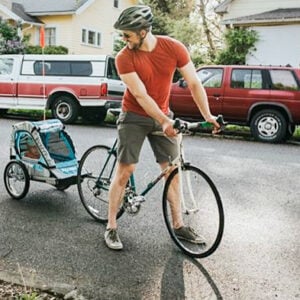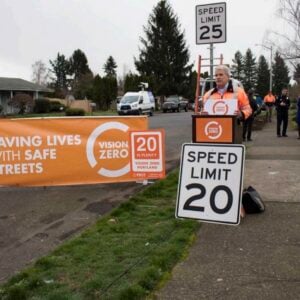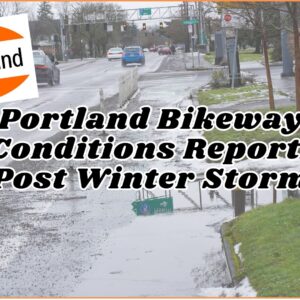
they biked during the storms last
winter. 78% of them said bikeways
were in poor condition.
(Photo © J. Maus)
Mayor Adams’ office has released the results of a survey they conducted to learn more about the experiences of people who rode their bikes through our spate of severe winter snow storms.
The bike survey was conducted separately from a general storm response survey because the Mayor’s office completely forgot about bikes in the first one.
The bike survey had about 450 respondents and the general survey had about 600. Here are the results of the bike survey:
1. Did you attempt to bike during the recent snowstorms?

2. If yes, were you able to reach your destination(s) by bike?

3. If yes, what were the conditions, for bikes, of Portland’s roadways?

4. Following the snow melt, how soon did the City remove gravel or storm debris from your bike route(s)

5. If biking is your primary mode of transportation and you chose not to bike during the storm, what were some reasons?

6. If bicycling is your primary mode of transportation and you chose not to bike, what mode of transportation did you most commonly use?

7. How would you rate TriMet’s accommodation for bikes during the storms?

The final question on the bike survey was open-ended and asked for other comments and suggestions. Reading through hundreds of responses, nearly all of them mention that gravel in bike lanes and on shoulders was (and still is in many cases) the biggest issue for bikes during the storm.
Here are a few of the responses (emphasis mine):
“bikers HAD to bike in the MAIN streets during the snowstorm(s) because that’s where snow had been worn from the roads. perhaps this should [be] a consideration–even if streets had bike lanes they were unusable. i bike 365 days of the year and i was terrified. and after the snowstorm and all of the snow had melted, i had to continue biking in the center of lanes because the sides of roads and bike lanes were full of gravel and littered with other debris such as branches.”
“post melt, road clearing should clear debris from entire road, not just car lanes.”
“i think the city’s man focus should be on cars and bikes last. choose other ways to get around like the bus.”
“It didn’t bother me much that we couldn’t bike in the snowstorm. What bothers me was that it took months to remove the gravel after the snow melted.”
“Snow ploughs [sic] push gravel, ice and snow in to the bike lanes. I ended up biking on the road after the major part of the storm was over. We need more and better separated bike facilities so that people can bike safely and comfortably no matter what the weather, and we need dedicated funding to maintaining bike facilities during storms. Autos are prioritized during storms, even though biking can be safer in bad weather. The city needs to start priotritizing [sic] bikes and walk the green talk.”
“After questioning a cyclist I saw, I tried getting on mine and was surprised at how easy it was to ride on the snow-packed roads. (Mountain Bike with off-road tires.)”
“Bike lanes and routes appeared to be the last for snow plowing as well as last for cleaning up gravel. The City’s maintenance efforts along bike routes year round is a great opportunity to “walk the talk” about bikes as a transportation option… Lots of room for improvement.”
“Why didn’t you clear bike boulevards? Why didn’t you clear painted bike lanes? Where’s the mode split for maintenance?“
“I think it just felt like pedestrians and bikers totally got the shaft, because the process of plowing the car lanes made sidewalks and bike lanes even less passable than if nothing had been done at all. It seems that walking, biking and public transit are the safest options for people in a storm like that, and yet two of the three of those were made nearly impossible…”
The City of Portland was obviously unprepared for a storm of this magnitude and they were in crisis-mode for several weeks. However, they also chose to almost completely ignore bike traffic in both policy and in practice. Despite this, many Portlanders chose to go by bike during the storms.
Not only were bikes a viable option for many, they also did nothing to contribute to the vast amount of damage that was done to our roads due to car tire chains and studded tires.
Hopefully next year, when another 100-year storm hits, the City of Portland can do a little more to accomodate bike traffic. At the least, I hope they don’t just forget about it completely.






Thanks for reading.
BikePortland has served this community with independent community journalism since 2005. We rely on subscriptions from readers like you to survive. Your financial support is vital in keeping this valuable resource alive and well.
Please subscribe today to strengthen and expand our work.
Truly the worst part of biking in all of this was after the snow was gone and having to deal with gravel and desbris in thebike lane for so long. It is easier to forgive the difficulty of removing the snow, but the crap aftewards lasted way too long.
I wonder to what extent the responses were skewed by respondents with an axe to grind or carrying a political motivation, esp. given the sensitization after not having been included in the first round of questions. That is, given all the negative press and pile on mentality in the bike community, did people get on and respond with prejudice more than a random sample at the time of the poor road conditions would have indicated (that is, sans aggrievement).
I’m not even that concerned about biking during a storm like that –
I agree that the worst parts are that the sidewalks were made almost totally impassable by the plowing of the road and that it took, in some cases, months to clean up afterward.
I’d be fine with walking and taking tri-met to places I absolutely need to get to during a storm, but it was impossible to walk on 3 feet of uneven, frozen over snow that had been dumped on the sidewalks, not to mention trying to jump into buses from the 3 foot piles of snow.
If you couldn’t get your car out of wherever it was parked when the snow hit, you were rendered almost completely immobile, and I think above focusing on bikes during a storm, that’s the bigger tragedy.
Excellent comments. The City spent the bulk of its effort bolstering the most dangerous transportation option.
-Ian
I got an idea, let’s be overly critical about how the city responded to the largest snow storm in the last 50 years!
Boohoo a little gravel our bike lane, it wasn’t that bad.
A little gravel? There is some still left, although it might be ODOT or even Beaverton in some cases.
Yes, it wasn’t even the roads or bike lanes, but the frozen plowed snow on the sidewalks. I took to skiing, but the uneven surface made even that difficult.
FWIW – They still haven’t finished cleaning the major bike routes of gravel, there are still hazardous accumulations in Ladd’s Circle among other places.
I really don’t have much of a complaint about gravel in the bike lanes. It definitely isn’t as pleasant a ride but it doesn’t make you ride impossible either. The worst part of the storm for me was after the main roads had been plowed for about a lane of traffic but the snow was still everywhere else. Having no other option other then riding in the only available lane on SE Division is not fun. Some drivers were understanding, some not. Even for the curtious drivers there was no room for them to move safely around me.
FWIW – They still haven’t finished cleaning the major bike routes of gravel, there are still hazardous accumulations in Ladd’s Circle among other places.
I might add that on my daily commute, (which takes me up Clay past the Keller Auditoruim) the roadsides are still replete with gravel. It’s March. MARCH.
I really could care less about how they handled the storm at this point. I’m more concerned that the city learn that they need to get better at undoing the hazards they create by trying to diminish the impact of the snow. This, I have yet to see.
Can I say it again? Gravel, downtown, on a busy street, on St. Patty’s. This is pretty egregious.
toddistic @ 5
+1 on the gravel
but we had a week long shutdown not more than 4 yrs ago, same M.O. from the City and from commenters on this blog
100 year storm? Short term memory there… The last storms were no where near the size of the winter blast the shut the city down for a week straight, in 2003. Lets keep things in perspective. During that storm after all the snow for a week, we had 3 inches of freezing rain on the cars, trees, and power lines. …starting to lose faith in the reporting on this website.
Oh, and asphalt lifts up and cracks, not just because of the studs and chains, but because during deep freezes, the water that seeps into the gravel of the asphalt expands when it’s freezing. Just like when you freeze a bottle of water in the freezer, that water expands as it freezes. The force of the water expanding loosens the gravel and is then broken loose from the glue that holds the gravel together. Therefore the road breaks up, pot holes are created, and the asphalt crumbles. That gravel on the asphalt cannot be fixed until the weather warms up… sheesh, do some research!!!
I agree that the main problem is gravel, which still plagues much of my commuter route, particularily SW Terwilliger. And far from being “unpleasant,” it’s downright dangerous when taking a curve on 23c road tires.
Here’s hoping the city takes note of the survey and comments, and works on cleaning the streets sooner.
I work at PCC-Sylvania and live in NE. As of last week, there was still gravel in the bike lanes down Capitol, Barbur, and almost all of the way into downtown. Not only did I feel less safe riding last week, but there was notably more dust in the air. Frustrating.
Hey City of Portland!!! There are sticks and twigs on my route from the wind storm last weekend.
Come on people, IT’S ALL PART OF RIDING IN THE WINTER AROUND HERE!!!
I hoped they learned something, because the next time we get that 100-year storm, which will be in about 2 years, they’ll have a great opportunity to test it out!
This was the worst snowstorm I’ve seen in the area in over 30 years. I didn’t ride my bike during THAT storm (in 1978), and I didn’t ride a whole lot during this one, either. While I missed riding my bike, it was clearly not safe to do so for many reasons.
What I didn’t appreciate was the glorifying — at this site and many others — of those who decided to brave the elements and ride their bikes no matter what. I tried to ride, twice. Both times I fell. That is not a reflection of my riding skill, OR of the city’s ability to clean the roads of snow and ice. It’s just what happens sometimes on a bicycle in obscenely ridiculous weather. People who exercised common sense by staying off their bikes were not wimps, they were just making choices that worked for them.
Here’s what I did appreciate the most: TriMet. The transit system, often denigrated at this Web site, actually did a difficult job heroically. During the storm, I got everywhere I needed to go, every day, by transit. Yes, it took longer, and yes, it was cold outside; but I GOT THERE. Let’s show some love for the drivers at TriMet when they do something really good, shall we?
Some of the Beaverton- Portland bus routes were severely limited. The max kept pretty good time whenever I wanted to use it though. Distance to stops, waiting, and the schedule are all reasons people don’t use the bus, and instead ride. It only got worse during the snow, so I don’t think Trimet counted as a great option most days. The snowbanks at all the bus stops didn’t help either!
I rode the first Sunday and I had no trouble with conditions, it was during the work week when the cars came back out that it started getting problematic. For me, the snow itself was not a problem, I only came close to falling once, when I tried to put my foot down on some ice. The problem is the cleared lane (which rapidly refroze each night) let drivers go much too fast on the plowed routes. Other less traveled streets were actually very nice to ride or ski on. Cars apparently make good ski groomers.
If the $54 bike registration fee does pass, those bike lanes better be cleared of all debris year round!
If the $54 bike registration fee does pass, those bike lanes better be cleared of all debris year round!
Thanks for publishing the results of the survey. I was curious about how it would turn out. It wasn’t too far off from what I expected/experienced.
I only rode the first day of the storm – took me 2 hrs. to go 10 miles about half was straight into the east wind! I quit riding due to my concern for safety.
When I started again the sand was so thick on my bike I decided to just wait until they cleaned it off the bike lanes so I wouldn’t have to clean it off the bike. The wait was much longer than I expected, especially when I was hearing that the city was working on the problem. Guess it was not along my route!
Alan Cordle (#15),
For the record, Barbur Boulevard is not swept by the City of Portland. It is swept by ODOT, and ODOT has swept it since the storm.
You and others might also be interested to know that, post-storm, some state-maintained roads like Barbur were swept before higher-volume roads primarily to provide clear bike lanes for cyclists. The very same ODOT crew was sweeping storm sand from I-405 today. It just really takes a long time to sweep the miles and miles of roads. At least in this case, the bike routes were given first priority. I can’t say why you’re still encountering gravel on Barbur, except to say that it gets swept regularly because it gets dirty regularly, storm or no storm.
I’m not sure who is responsible for Hwy 30 (ODOT?) but I rode out to Sauvie Island a few weeks ago and it was so full of gravel it posed a serious hazard. I had to ride way closer to the road and cars than I wanted to, just avoid going down on the big chunks of rock.
The gravel wasn’t just an inconvenience while it was on the ground. The sweeping crews were out cleaning it up along 92nd between stark and foster a couple of nights on my way home. I couldn’t keep my eyes open from the dust, and could barely breathe to get past them! I know, complain,complain!
#23 Machu Picchu
Thanks for the info. If you know anyone at ODOT, please ask them to take a look. The sweeper did not do a good job. It seems like the gravel all along Barbur just got swept over into the bike lanes.
duncansadat:
I’ve noticed a lot of gravel around town on my commute that’s created gradually by tires passing through eroding potholes, and not a result of sand/gravel laid down during the december storms.
FYI.
Alan #23,
I’m the person that I know at ODOT. I look at it every day. And since I work in maintenance and not PR, I have said enough already. Except that I have put a lot of work into trying to clean that road, and if your perception is that someone didn’t do a good job, then I don’t know what to tell you. Enjoy your gravelly ride, because unless you sweep it to your own satisfaction, I don’t think you’re going to be happy.